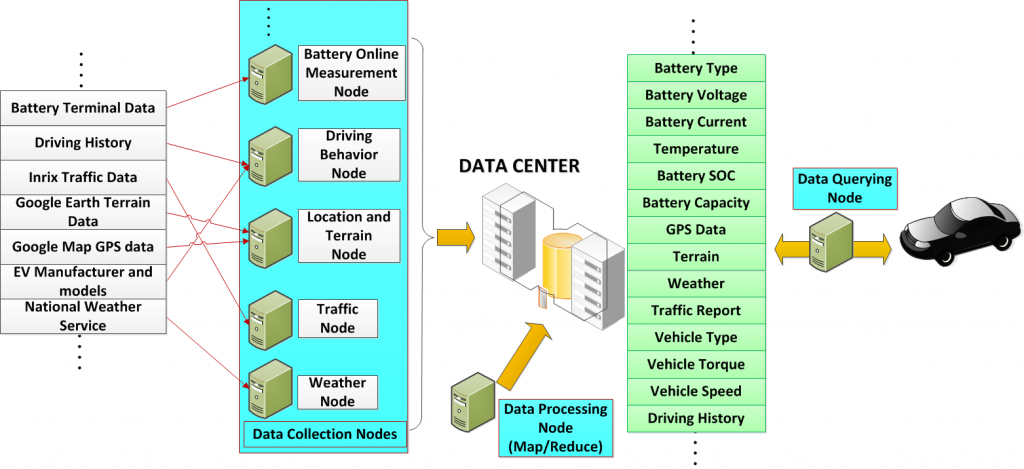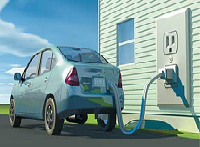
by chow | Oct 28, 2015 | Completed projects
The goal of this project is to develop a cooperative distributed Home Energy Management System (HEMS) for 1) a single house, and 2) aggregated houses. In this cooperative distributed HEMS, energy sources and loads can coordinate and cooperate with each other to maximize the user comfort, meet the power constraints (e.g., avoid over-loading), optimize the power flows, decrease the system cost and the electricity bill in a single house and among aggregated houses. It also includes smart battery charging/discharging strategies to optimize the integration of the energy storage system. The project consists of design, development and demonstration phases.

by chow | Nov 14, 2014 | Completed projects

Project Description
The amount of data collected in Electric Vehicles has been growing fast because we have many more sensors, higher bandwidth communication systems, and cheaper memory to monitor and measure real-time driving range related data and store the data on the vehicles, in connected clouds, etc. This massive amount of data can have different levels of accuracy, resolutions, and relevance in unstructured ways. Big Data technologies have been emerging to address huge, diverse and unstructured data to substantially improve the overall system performance. With proper use of Big Data concepts and techniques, the remaining driving range estimation of the vehicle can be substantially improved.
The range estimation needs the incorporation and synchronization of all standard, real-time and historical data. Usually, the standard and historical data provides an initial prediction of the driving range; and the real-time data updates the estimation during the driving. However, under different conditions, some data are more relevant than others for the range estimation. This data can be historical, standard, or real-time depending on different situations. The big data analytics helps us identify the relevant data and discover its correlation to the remaining driving range estimation.
Publication
- H. Rahimi-Eichi and M.-Y. Chow, “Big-Data Framework for Electric Vehicle Range Estimation,” presented at the 40th Annual Conference of the IEEE Industrial Electronics Society (IECON2014), IEEE, Dallas, TX , 2014.
Link
Samsung Advanced Institute of Technology (SAIT)

by chow | Jul 28, 2014 | Completed projects

Designing efficient demand management policies for charging Plug-in Hybrid Electrical Vehicles (PHEVs) and Plug-in Electrical Vehicles (PEVs) is becoming a vital issue as increasing numbers of these vehicles are being introduced to the power grid. Since these vehicles utilize grid power for charging, this growth could pose potential threats and benefits for the existing power grid. The main challenge is that when large number of PHEVs/PEVs simultaneously connect to the grid, the overall power system quality and stability could be severely affected due the large amount of power consumption. On the other hand, by smartly controlling the charging process, the utility can utilize the flexible nature of these loads for peak shaving and valley filling to improve the quality of power.
Conventionally, optimal managing of the charging process requires gathering data in a single node and performing a central optimization. However, as the scale of the problem increases to consider thousands of charging stations distributed over a vast geographical area, the central approach would suffer from vulnerability to single node/link failures as well as computational scalability. In this project, the central demand management unit is eliminated and the global optimal power allocation under all local and global constraints is reached by peer-to-peer coordination of charging stations. This approach is highly efficient in terms of computational and communicational effort, considering that the overall demand management problem is large scale and nonlinear. Moreover, using distributed approach, the demand management system gains robustness against single link/node failures.
Publications:
[1] N. Rahbari-Asr and M.-Y. Chow, “Cooperative Distributed Demand Management for Community Charging of PHEV/PEVs Based on KKT Conditions and Consensus Networks,” IEEE Transactions on Industrial Informatics, vol. 10, no. 3, pp. 1907–1916, 2014.
[2] N. Rahbari-asr, M.-Y. Chow, Z. Yang, and J. Chen, “Network Cooperative Pricing Control System for Large-Scale Optimal Charging of PHEVs / PEVs,” in IECON 2013-39th Annual Conference on IEEE Industrial Electronics Society, 2013, pp. 6148–6153.
Links
by chow | May 27, 2013 | Completed projects

When looking forward towards Intelligent Transportation Systems (ITS), driver warning systems are an integral part of an ITS. There is a need for warning systems that can integrate the information that is currently available in the vehicles with the information about the environment in order to make more informed and accurate decisions. These warning systems should be supported by roadside infrastructures for the acquisition and processing of global/environmental information. In such systems, the roadside infrastructures need to communicate a large amount of time-sensitive data to many of the vehicles. In such a large-scale time-sensitive system, real-time information extraction (e.g. determining the risk for each vehicle) and optimal resource (e.g. bandwidth) allocation are crucial yet computationally demanding.
This project will investigate and develop gene library based real-time information extraction and resource allocation methodology that can be adaptively tuned using the concepts of Artificial Immune System (AIS). This gene library is designed to extract only the relevant information from a vehicle to determine abnormality/risk in vehicle movements at various traffic environments and to provide optimal real-time sampling rate adaptations and emergency interventions based on the information.
Documentations
Links
by chow | Sep 27, 2012 | Completed projects
by chow | Sep 27, 2012 | Completed projects
Fig. 1 Intelligent Space via Network-Based Control.
Project Description:
The main objective of the Intelligent Network-Based Control Project is to develope a wireless unmanned vehicle to find its way through a platform with obstacles. It should arrive at the destination specified by a user in a remote location using the shortest amount of time, and avoiding any collisions.
Main Focuses:
- How to recognize the vehicle and obstacles.
- How to generate a path around the obstacles in the shortest amount of time.
- How network delays contribute to control errors.
The vision of the vehicle is established by a wireless network camera placed on top of the platform. The vehicle is battery operated and completely controlled by wireless communication via IP network. Image processing technology, as well as hardware and software implementations are utilized to demonstrate the path generation and path tracking algorithms. Gain Scheduler Control algorithm may also be implemented in this project to compensate for any network delay disturbance.
 Fig. 2 Path generation algorithm.
Fig. 2 Path generation algorithm.Publications:
Y. Tipsuwan, M.-Y Chow, “Neural Network Middleware for Model Predictive Path Tracking of Networked Mobile Robot over IP Network,” IEEE IECon’03, Roanoke, VA, Nov 2 – Nov 6, 2003.
Y. Tipsuwan, M.-Y. Chow, “An Implementation of a Networked PI Controller over IP Network,” IEEE IECon’03, Roanoke, VA, Nov 2 – Nov 6, 2003.
Y. Tipsuwan, M.-Y. Chow, “On the Gain Scheduling for Networked PI Controller Over IP Network,” 2003 IEEE/ASME International Conference on Advanced Intelligent Mechatronics, Port Island, Kobe, Japan, July 20-24, 2003.
Y. Tipsuwan, M.-Y. Chow, “Gain adaptation of mobile robot for compensating QoS deterioration,” Proceedings of IECon’02, Sevilla, Spain, November 5 – 8, 2002.
Y. Tipsuwan, M.-Y. Chow, “Network-Based Controller Adaptation Based On QoS Negotiation and Deterioration,” IECon01, Denver, CO, Nov.28-Dec.02, 2001, pp. 1794 -1799.
Y. Tipsuwan, M.-Y. Chow, “Network-based control adaptation for network QoS variation,” MILCOM 2001, October 28-31, 2001, McLean, VA, pp. 257-261.
M.-Y. Chow, Y. Tipsuwan, “Gain Adaptation of Networked Dc Motor Controllers on QoS Variations,” IEEE Transactions on Industrial Electronics, Vol. 50, no. 5, October, 2003.
Y. Tipsuwan and M.-Y. Chow, “Control Methodologies in Networked Control Systems,” Control Engineering Practice, vol. 11, 2003, pp.1099-1111.
M.-Y. Chow, “Methodologies in Time Sensitive Network-Based Control Systems,” 2003 IEEE/ASME International Conference on Advanced Intelligent Mechatronics, Port Island, Kobe, Japan, July 20-24, 2003.
M.-Y. Chow, Y. Tipsuwan, “Real Time Network-Based Control System,” IEEE IECon 2002 Tutorial, Sevilla, Spain, November 5, 2002.
M.-Y. Chow, Y. Tipsuwan, “Network-Based Control Systems: A Tutorial,” Proceedings of IEEE IECon 2001 Tutorial, November 28 – December 2, Denver, CO, pp. 1593 -1602.








